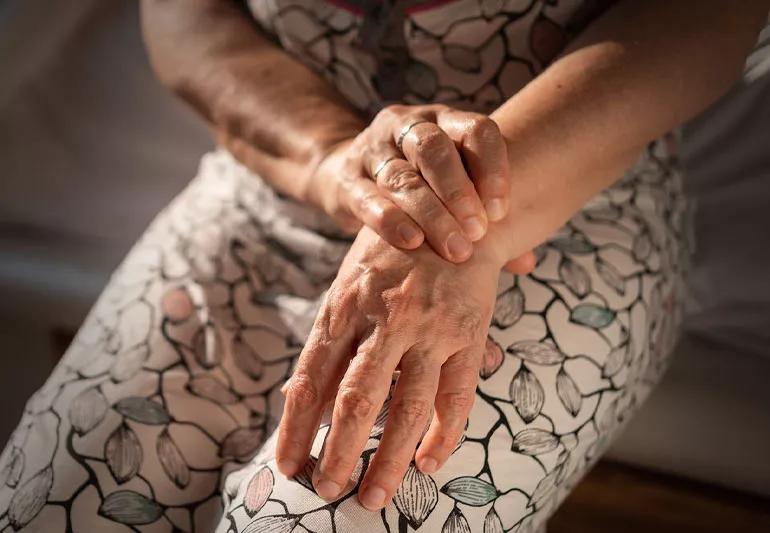Simple exercises like tendon glides and finger lifts can have a big impact

Hand arthritis can be extremely painful, limit your ability to move and sap your hand strength. And unlike other unwelcome houseguests, it’s usually there to stay.
Advertisement
Cleveland Clinic is a non-profit academic medical center. Advertising on our site helps support our mission. We do not endorse non-Cleveland Clinic products or services. Policy
When you start limiting your activities and movement due to arthritis pain, your tendons can shorten over time, leading to the telltale signs of advanced hand arthritis (think: knotted joints and bent, curled fingers).
Eventually, everything gets so tight that it makes it that much harder — and more painful — to recover your range of motion. That’s why it’s critical to prevent worsening symptoms now rather than try to restore function later. And exercise is a natural antidote.
“Hand strengthening exercises for arthritis help you protect your range of motion and function so you’re able to grasp objects and perform fine motor tasks like buttoning or zippering,” explains occupational therapist and certified hand therapist Jesse DeFilippo, OTR/L, CHT. “More motion equals more mobility, and that usually leads to less pain and better functioning.”
When you’re doing exercises for hand arthritis, it’s important to let pain be your guide, DeFilippo says.
“If they hurt, stop doing them. Do everything to your tolerance,” he advises. “The point is not to force anything. It’s to gradually build your tolerance to motion and light strengthening.”
You should also avoid these movements if you’re experiencing an arthritis flare-up, which involves a sudden increase in joint pain and inflammation.
Advertisement
So, how often should you do your hand and wrist exercises? It depends on the exercises themselves. “Stretches and non-resistive movements are OK to do every day,” DeFilippo says, “but weighted and resistance-based exercises should only be done three times a week.”
These 16 movements can get you on the road to arthritis symptom relief.
Rolling a ball along your hand is a great way to warm it up before you exercise. “It’s a nice massage and stretch for your muscles and tendons,” says DeFilippo.
To do it:
Using therapy putty provides a warm-up effect, too. It’s a type of modeling putty that has different levels of pliability and resistance.
“I have patients roll it out to loosen and warm things up, but there are therapy putty exercises that help strengthen arthritic hands, too,” DeFilippo says. “Spending 10 to 15 minutes three times each week working on some of these therapy putty exercises can be beneficial.”
Here are a few (dare we say a handful?) to try:
Tendon glides are great exercises to maintain range of motion in your fingers. They involve a series of four hand movements.
“These movements isolate each motion that your fingers can do,” DeFilippo explains.
To do tendon glides:
“Do them as many as 10 times in a sitting, three to five times each day, to help keep everything moving smoothly,” DeFillippo recommends. “Treat it like your meals. Do it first thing in the morning, at midday and then toward the end of the day around dinnertime.”
Wrist flexion and other wrist movements can help arthritis in your wrist joint.
Advertisement
“Just the process of actively moving your wrist to the best of its ability leads to an increase in range of motion and tolerance to that activity over time,” DeFilippo says.
To do wrist flexions:
Like wrist flexion, wrist extension can help ease arthritis in your wrist. It’s a similar motion, but in the opposite direction.
To do wrist extension:
Finger blocking isolates and moves your finger joints. With the thumb or index finger from your opposite hand, you’re blocking a finger from moving down to your palm as you bend it.
Advertisement
To do finger blocking:
Reverse blocking is similar, except you bend your fingers at your MCP joints (knuckle joints). You can do four fingers at the same time by using the entire length of your opposite finger to block them.
Finger lifts are a great way to increase the range of motion in your fingers and prevent pain.
To do finger lifts:
Starting a thumb exercise regimen is more complicated.
“I don’t recommend that people start one unless they see a therapist who can give them an outline of specific exercises to do,” says DeFilippo. “Splinting is often needed for thumb arthritis to protect the joint while you use your hand. And it’s crucial to avoid pinching activities and movements that will hyperextend your thumb and put more stress on the joint.”
Because thumb arthritis affects your carpometacarpal (CMC) joint at the base of your thumb, the most effective exercises strengthen the muscles supporting it. Try these three exercises to help thumb arthritis symptoms:
Advertisement
DeFilippo recommends seeing a physical or occupational therapist if the pain gets in the way of any of your daily activities.
“On a scale of 1 to 10, if your pain is at a 2 or 3, that’s probably manageable,” he says. “But if you’re at a 6 to 8 every day, get help right away — especially if the pain has increased over time or your personal pain management techniques aren’t working.”
Remember that, when it comes to hand exercises for arthritis, consistency is key.
“In my experience, it takes about three to four weeks for patients who consistently do their exercises at home and in combination with therapy appointments to experience noticeable relief,” DeFilippo says. “Often, they feel like they’re able to increase their range of motion, and if they were sore, it reduces their pain.”
Learn more about our editorial process.
Advertisement

Research doesn’t show any benefits to wearing copper bracelets — but your experience may vary

Yes, your genetic makeup may increase your risk of developing arthritis, but other factors like age and weight can play a role, too

Both types of therapy work differently, but they can both alleviate symptoms — especially when you alternate methods

The process usually starts with your primary care provider, who may refer you to a rheumatologist or orthopaedist

Exercising can actually improve arthritis symptoms — and low-impact exercises are best

Research is inconclusive, so don’t stop eating tomatoes, potatoes and peppers just yet

Adding these simple foods to your diet can make a big difference

Here's how to make yourself more comfortable behind the wheel

Babies can get congested easily, but you can calm their cough by keeping them hydrated, using nasal drops and running a humidifier

Weight loss may cause loose, sagging skin and muscle loss to your rear

Several conditions, like vitiligo and fungal infection, can cause a loss of pigmentation, leading to white spots or patches on your skin